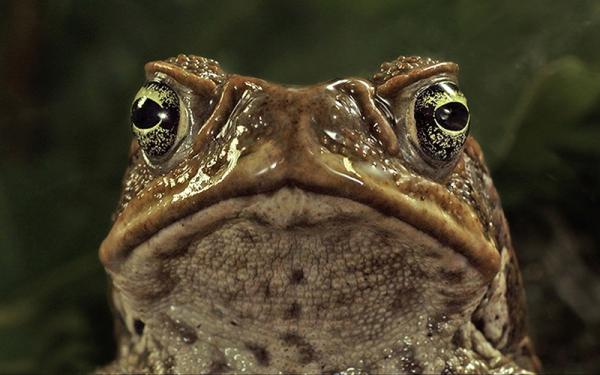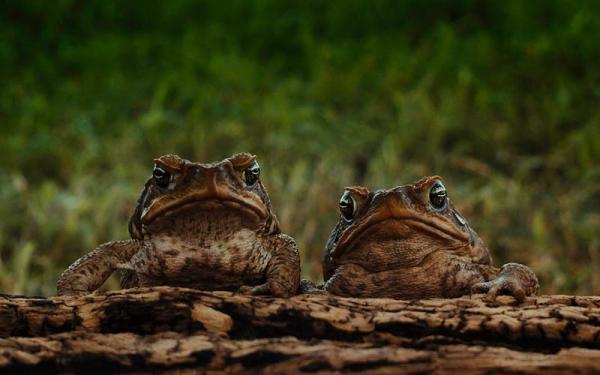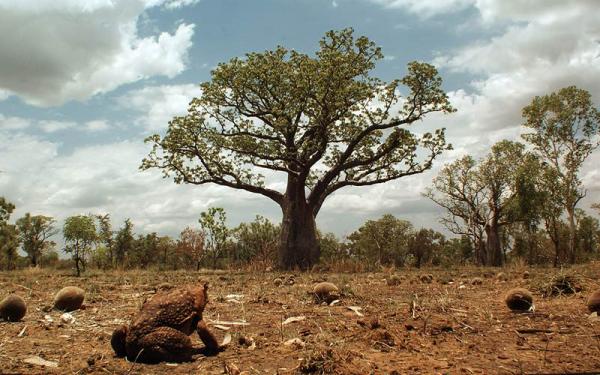Cane Toads Invade, Conquer Australia


When beetles began devouring sugar cane fields in Queensland, Australia, in the 1930s, farmers got desperate.
Nasty, primitive pesticides were a last resort, so they explored other options. Tales quickly spread of a toad that loved nothing more than to dine on cane beetles. The thinking went that a few hundred cane toads which can grow as large as dinner plates and weigh up to 4.5 pounds (2 kilograms) would gobble up all the cane beetles so that farmers could get back to farming.
In 1935, two suitcases of South American cane toads made the journey from Puerto Rico where a similar scheme was successful to Hawaii and then on to Australia. Rather than hang out in the cane fields though, those original 102 toads set out across the continent and have mushroomed in number to more than 1.5 billion.
Today, toads have conquered more than 386,000 square miles (1 million square kilometers) of Australia. This is equivalent to an area slightly larger than the states of Texas and Oklahoma combined. Since their release in Queensland (in the northeast of Australia) 75 years ago, cane toads have pushed 1,506 miles (2,424 km) west to Kununurra, just inside the Western Australia border.
While biologists scratch their heads about how to corral the toads, many Australians can't hide their transparent hate of the bug-eyed creatures (a clever few entrepreneurs have made a buck or two off them with cane-toad leather purses and traveling toad shows). Town mayors encourage toad bashing, and locals deploy MacGyver-worthy contraptions to catch and kill cane toads. Roads in some towns are so spotted with toads that squishing them under car tires has become an unavoidable part of the daily commute.
The only ones that seem pleased are dogs they get addicted to licking the toads for a trippy LSD-like high until they eat one and overdose.
In the movie "Cane Toads: The Conquest," which made its New York debut last week, these scenes unfold in three dimensions. Behemoth toads leap-frog each other, fling their tongues at the audience, or just sit and stare in director Mark Lewis' follow-up to his 1988 cult-classic "Cane Toads: An Unnatural History." The documentary is an endearing and often comedic look at the invasive species .
Get the world’s most fascinating discoveries delivered straight to your inbox.
"It's not their fault; they were brought in against their will," Lewis told OurAmazingPlanet. "They're just doing what they're good at, which is thriving and multiplying."
The Conquest
Cane toads (Bufo marinus) were a complete failure at killing Australia's sugar cane-ravaging beetles. Instead of controlling the pests, the toads have become pests themselves. A healthy sex drive and a concealed deadly chemical defense system have transformed them into one of the world's top 100 invasive species.
They have such a strong sex drive, in fact, that scientists have caught them mating with rocks, clumps of dirt, human feet and road kill. They mate year-round and females lay up to 30,000 eggs at a time.
Despite their aggressive mating, cane toads are lazy hunters. They hang out under street lights or mosquito zappers and lap up any insects that fall to the ground.
It's probably best that cane toads don't have to hunt since they're not physically threatening. They can get big one of the biggest ever found is about the size of a Chihuahua although they aren't very fierce. But hidden behind the bulbous lumps behind cane toads' eyes are glands that secrete toxins. Toads may look like a juicy meal to predators, but they contain enough venom to take down a large crocodile. The Australian outback is littered with animals such as kangaroos that died after swallowing a cane toad.
Rapid mating and deadly toxins helped the toads spread at a rate of about 6 miles (9.7 km) per year from the 1940s through the 1960s. Now they're taking over at a rate of about 30 miles (48 km) per year. Researchers have discovered that toads are bounding across the northern tropics of Australia faster than ever, thanks to the evolution of longer legs.
In a 2006 study, researchers found that those toads that first reached Australia's northern port city of Darwin had legs that were up to 6 percent longer than average. The study also showed that newer populations of toads tended to have longer legs than those in long-established populations.
Other prized cane toad qualities combine to create a prototypical invasive species. Toads can live partly on dry land so they aren't confined to tropical climates. Their ballooning body size stores water to prevent dehydration during treks across the outback. Toads even have a type of energy-storing fat to spark their long journeys.
The cane toad is such a good invasive species that bottling their spread may be impossible, director Lewis said.
Getting along
The cane toad conquest is obvious, but the cane toad solution is not, despite more than $20 million Australian dollars ($17 million USD) spent on toad control.
"The reality is that whatever they try doesn't work: genetic modification, picking them up, traps whatever it is, it's ineffective," Lewis said.
Pesticide spraying has been the only solution that has worked. However, once scientists discovered the pesticide they were using causes cancer in humans the spraying was banned. The toads repopulated seemingly overnight.
Desperate cities and towns have resorted to luring tourists with Whack-a-Toad safaris. Exasperated homeowners bait traps with electronic mating calls. Killing cane toads has turned into an every-man-for-themselves sport.
Cane toads are not protected by Australian wildlife regulations, but they are covered under animal-welfare laws, so any killing must be humane. Australia's Royal Society for the Prevention of Cruelty to Animals (RSPCA) suggests putting the toads to sleep in a refrigerator for 12 hours, and then placing them in a freezer for 24 hours. The RSPCA's previous suggestion of putting them to sleep by smearing hemorrhoid cream on their backs never caught on.
Killing a few toads here and there is about as helpful as raking leaves from a yard, however. It will tidy things up, but the leaves will be back again next week.
Cane toad surveys show that the invasion is moving just as fast as it was before community groups and governments began toad collecting. Killing 98 of 100 toads around a pond leaves two toads that can produce 30,000 new babies the next night. Even if many of those eggs and tadpoles die, there will still be 10 times as many toads around that pond in a week, according to the Web site CaneToadsinOz.
Many Australian cities have simply thrown in the towel on the cane toad fight. After scientists discovered toads that had been breeding in Sydney, a federal government report concluded that "the eradication of cane toads is not currently possible."
"I think the scientific consensus is that we can't stop the toads from spreading, but we can do all kinds of things to reduce their densities and their impact," said biologist and cane toad expert Richard Shine of the University of Sydney.
Shine is researching new methods to do just that, such as teaching predators to leave them alone so they don't die from a toad meal. This part of Shine's research learning to live together with the toads is known as cohabitation, and it may be the only solution.
"After they've been in an area for some time, everyone gets used to everyone," Lewis said.




